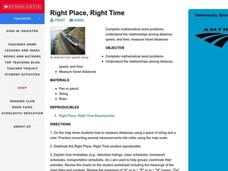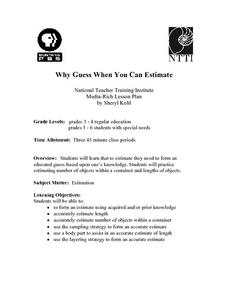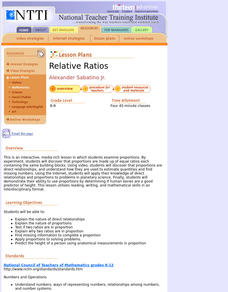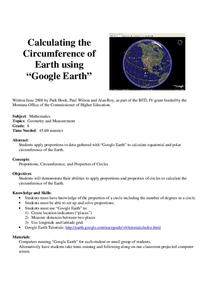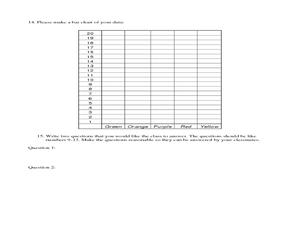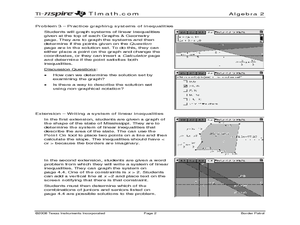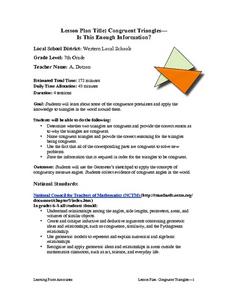Curated OER
Percents: What's the Use
Learners research percentages in real world situations. In this percents lesson, students demonstrate their ability to apply percents to everyday situations. Learners communicate mathematically by conducting interviews about percents and...
Curated OER
Right Place, Right Time
Fourth graders complete mathematical word problems. They study the relationships among distance, speed, and time; and measure travel distances. They measure distances using a piece of string and a ruler and practice converting several...
Curated OER
Why Guess When You Can Estimate
They apply various strategies in their estimations. They analyze the differences between guessing and estimating. They estimate the number of beans and jellybeans in egg cartons and jars respectively.
Curated OER
Relative Ratios
Students discover that proportions are made up of equal ratios each containing the same building blocks. They, using the Internet, apply their knowledge of direct relationships and proportions to problems in planetary science.
Curated OER
Pay Check Advance Loan
Learners research loans. In this financial lesson, students explore the benefits and drawbacks of applying for a pay-day advance loan. Learners compare different programs and calculate interest owed. Multiple resources are provided.
Curated OER
Getting a Little "Lift"out of Calculus
Young scholars, after entering the given conditions into FoilSim, apply calculus techniques to verify predictions.
Curated OER
QUILTING AND COMBINATIONS
Young scholars apply problem solving procedures and skills to solve a given real life problem by manipulating felt squares to represent the possible combinations for a two color quilt.
Curated OER
Jazz and Math: Improvisation Permutations
Students explore the various rhythmic combinations in jazz and blues music. They watch a video segment, apply a mathematical formula to calculate the number of possible rhythmic combinations, and perform a combination of notes and...
Curated OER
Baseball Geometry
Students apply various methods for finding the volume and surface area of sphere. They compare and contrast results among these mathematical methods. They work in cooperative groups to discuss their results with one another.
Curated OER
I'll Halve S'More, Please!
Students describe a fraction in terms of sharing parts of a whole. They understand the meaning of the parts of a fraction and add and subtract like fractions. They apply fractions to problem situations and recognize and use equivalent...
Curated OER
Money Math: Lessons for Life
Students explore money as it applies to salary, paychecks, and taxes. In this essential mathematics lesson, students explore how math is used in various careers, how income takes are calculated and other important life lessons in math.
Curated OER
Calculation the Cricumference of Earth using "Google Earth"
Eighth graders investigate properties of circles. In this eight grade mathematics lesson plan, 8th graders apply proportional reasoning to data gathered with “Google Earth” to calculate equatorial and polar circumference of the Earth.
Curated OER
Deric's Blotto
Students solve the handshake problem and investigate triangular numbers. In this geometry lesson, students investigate Blotto games as they apply concepts of triangles and geometric theorems.
Curated OER
Using Ratios to Taste the Rainbow
Students solve problems using ratios and proportion. In this algebra lesson, students analyze skittles and their different colors as they apply the properties of ratios and proportions to solve their problems.
Curated OER
Length, Perimeter and Area
Learners analyze characteristics and properties of two- and three-dimensional geometric shapes and develop mathematical arguments about geometric relationship
Curated OER
Newton's Laws
Young scholars identify Sir Isaac Newton and his contribution to physics. They write Newton's three Laws of classical mechanics. and apply Newton's Laws to the world around them. They isolate a situation and apply Newton's Laws.
Curated OER
Building Shapes From Numbers
Students experience how to illustrate some of the many connections between number and geometry. Through this 2-3 day focus on square numbers and triangular numbers, students make connections among mathematical topics.
Curated OER
Mandalas, Polygons and Symmetry
Students create a geometric pattern using mandalas, polygons and symmetry. In this geometry lesson, students analyze the mathematics involved in making the mandalas, including the shapes and symmetry. Students create their own mandalas...
Pennsylvania Department of Education
Equal Groups
Students explore statistics by completing a graphing activity. In this data analysis lesson, students define a list of mathematical vocabulary terms before unpacking a box of raisins. Students utilize the raisins to plot data on a line...
Curated OER
Management of Wildlife Resources
Students investigate how wildlife management policies affect the size of large animal populations. They develop a spreadsheet that incorporates a mathematical model to predict big game herd sizes, and using worksheet data manage a bison...
Curated OER
Intuitive Approach to Limits
Students identify and comprehend the concept of limit in mathematics. They also view artistic works illustrating limits by M. C. Escher and apply techniques of one-sided limits to graphs of relations. Finally, students compute limits...
Curated OER
Border Patrol ID: 11603
Incorporate technology in your classroom by teaching your students how to graph systems of linear inequalities as they apply to an area of land. The lesson provides an extension in which students are challenged to write a system of...
Curated OER
Planets in Proportion
Students apply estimation strategies and proportional reasoning to determine a scale comparing the planetary bodies to Earth. They convert measurements of time and distance using scientific notation. Both the metric and customary units...
Curated OER
Congruent Trianges - Is This Enough Information?
Seventh graders determine whether two triangles are congruent and provide an explanation to why they are not. They apply concepts of measurement of angles and collect evidence of congruent angles in the world.



